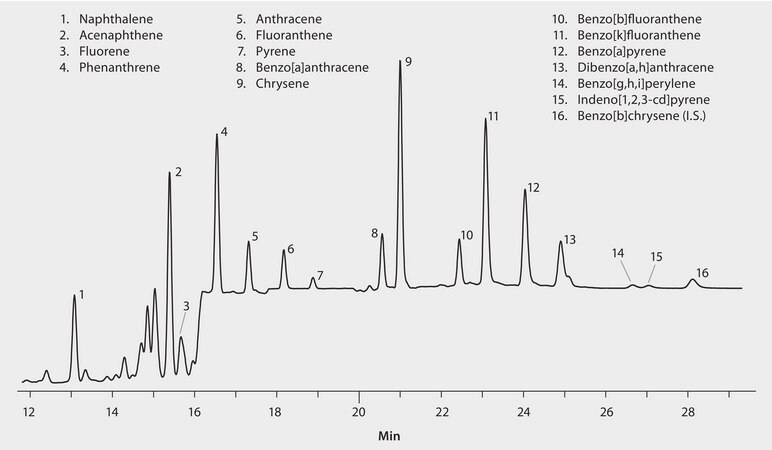HPLC Analysis of PAHs in Canola Oil on SUPELCOSIL™ LC-PAH after SPE using Supelclean™ EZ-POP NP

Matériaux
Colonne analytique
Tube ou plaque pour SPE
Étalon
CONDITIONS
sample preparation
SPE (Solid Phase Extraction)
sample/matrix
Canola oil spiked with PAHs at 10 ng/g
SPE tube/cartridge
Supelclean™ EZ-POP NP, 12 mL, pk of 20 (54341-U)
condition
10 mL acetone, dry under 10-15" mercury for 10 minutes
sample addition
0.5 mL weighed accurately onto cartridge
elution
15 mL acetonitrile
eluate post-treatment
concentrate to final volume of 0.5mL at 40 °C under nitrogen
column
SUPELCOSIL™ LC-PAH 25 cm x 4.6 mm I.D., 5 μm particles (58229)
mobile phase
[A] water [B] acetonitrile
gradient
40% B held for 5 min; to 100% B in 15 min; held at 100% B for 12 min
flow rate
2.4 mL/min
pressure
2790 psi at start (192 bar)
column temp.
25 °C
detector
Fluorescence, programmed.
Description
Remarque sur l'analyse
PAHs are ubiquitous in the environment, resulting from both natural and manmade sources of combustion. They can contaminate food crops through environmental exposure to particulates, automobile exhaust, etc. In the case of edible oils, additional PAHs can be introduced during actual production processes such as seed drying [1]. In this application, EZ-POP NP SPE is used to extract PAHs from soybean oil. The 16 PAHs designated in many US EPA methods (less acenaphthylene) were analyzed by HPLC-FLD after extraction from a spiked sample of oil.
Autres remarques
Detector: Naphthalene, Acenaphthene, Fluorene - 225nm/320nm; Phenanthrene, Anthracene - 250nm/368nm; Fluoranthene, Pyrene - 237nm/440nm; Benzo[a]anthracene, Chrysene - 265nm/380nm; Benzo[b]fluoranthene, Benzo[k]fluoranthene, Benzo[a]pyrene, Dibenzo[a,h]anthracene - 280nm/420nm; Benzo[g,h,i]perylene, Indeno[1,2,3-cd]pyrene, Benzo[b]chrysene - 300nm/466nm
Informations légales
SUPELCOSIL is a trademark of Sigma-Aldrich Co. LLC
Supelclean is a trademark of Sigma-Aldrich Co. LLC